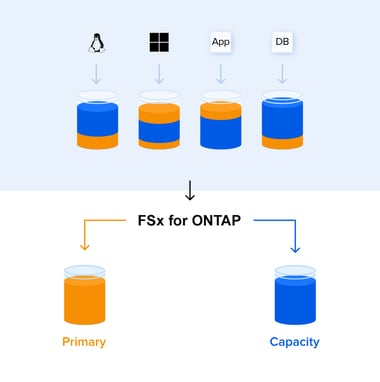Subscribe to our blog
Thanks for subscribing to the blog.
February 1, 2024
Topics: Amazon FSx for NetApp ONTAP Storage EfficienciesAWSCustomer Case StudyAdvanced9 minute read
Storage is a foundational pillar of any cloud architecture. But it can be a real challenge to keep storage costs under control. Storage is already a heavy line item in a monthly bill—and as storage usage grows, so does your overall TCO.
From the huge amounts of data being stored these days to the redundant costs that come with storing DevTest, backup, and disaster recovery copies, you need to find a way to reduce your overall storage footprint and optimize the resources you’re already using.
This blog dives into those challenges, and explores the Amazon FSx for NetApp ONTAP storage efficiency features that can help you reduce your storage footprint and usage by up to 65%—or even more.
Keep reading for the full details, or jump down to read about what interests you most:
- Why managing storage costs is a challenge
- Optimize your storage costs with FSx for ONTAP
- How Arcesium reduced storage costs 40% with FSx for ONTAP
- Beyond savings: Other benefits of FSx for ONTAP
- Transform your storage costs with FSx for ONTAP
Why managing storage costs is a challenge
Managing your storage expenses can be more complex than it seems. If you aren’t careful, you can lose track of data growth, operational demands, and effectiveness, and wind up spending more than your budget.
How can storage expenses get that out of control? Let’s consider some of the challenges:
- All that data adds up
By nature, enterprise-grade operations accumulate huge amounts of data. Carrying a large data estate adds to operational overhead and increases total costs of operation. - The data lifecycle can be long
Most likely, the data that organizations store will become less critical as time goes on, and eventually can be deleted. But other data may need to be retained—whether for audit, compliance, or reference purposes. That data can become a cost concern over time, especially if it isn’t using the most appropriate storage tier. - Agile delivery affects storage
In the agile process of continuous integration and continuous deployment (CI/CD), developers create hundreds of copies of datasets to use in DevTest environments. This is time consuming and costly: Most storage environments can only create full copies of the data, and each copy consumes the same amount of storage as the original. - Not all storage types are warehouses
Some datasets are more heavily accessed than others. To use cloud storage effectively, you need to use the right storage service for each kind of data, depending on how the data is used. - Backup and DR data storage demands
Backup and disaster recovery (DR) copies are necessary protections for your operations. But that means carrying additional storage capacity: You need at least one complete copy of your dataset, if not more.
Finding solutions to these challenges can have a huge impact on your storage costs, your storage performance, and your TCO. And AWS and NetApp have joined forces to provide just that solution: Amazon FSx for NetApp ONTAP.
Optimize your storage costs with FSx for ONTAP
FSx for ONTAP delivers industry-trusted NetApp® ONTAP® storage management capabilities as a first-party service managed entirely by AWS. Using built-in FSx for ONTAP storage efficiency features can help you reduce your data footprint and overall storage costs by up to 65%.
- Thin provisioning
With the thin provisioning feature, FSx for ONTAP allots space without having to reserve the same amount of physical storage in advance. This helps you avoid overprovisioning.
With overprovisioning, storage is allocated and incurs costs even though it doesn't get used immediately, or ever. Thin provisioning addresses that problem by dynamically allocating storage only as it’s needed. You pay only for what gets used, not for idle resources. - Compression
FSx for ONTAP leverages the adaptive compression capabilities of ONTAP. This transparent compression significantly reduces storage consumption and brings down the storage cost. - Deduplication
FSx for ONTAP continually scans your data for duplicate data blocks. When it finds identical data blocks, the system attaches a pointer to the original block instead of creating a new full copy of the data. That means only unique data blocks are stored, which eliminates duplicate data points and reduces the overall storage footprint. This process is done automatically, transparently, and with no performance impact. - Compaction
The data block size used by FSx for ONTAP is 4KB. Some applications perform small writes that might not use the entire data block. The compaction feature optimizes use of the entire storage block by packaging multiple smaller chunks of data that have already been compressed and deduplicated into that space. The underlying storage is fully utilized, so there’s less raw storage than you need to pay for.Built-in storage efficiencies make your data more lightweight
- Cold data tiering
To maximize efficiency while minimizing costs, FSx for ONTAP uses FabricPool policy-based features to dynamically move data blocks between primary and capacity storage tiers based on data access patterns.
On FSx for ONTAP, the primary tier is high-performance SSD storage, ideal for frequently accessed data. The capacity pool layer uses lower-cost storage for infrequently accessed data. If the tiered data is ever needed again, it’s automatically “reheated” and sent back to the SSD primary tier.
Storage tiering automatically moves infrequently accessed data to low-cost storage
- Lightweight Snapshot copies
FSx for ONTAP uses NetApp Snapshot™ technology to facilitate storage-efficient, point-in-time backup copies of your data. Snapshot technology creates read-only pointers to individual data blocks. A pointer is updated only when data is changed in its specific block in the primary copy.
This use of pointers is what makes Snapshot updates incremental: New copies simply point back to any changed or added blocks since the most recent Snapshot operation, instead of re-creating the entire volume. This method considerably reduces the amount of storage space your backups need to use.
Snapshots with minimal capacity increase
- Thin-clone copies
One of the most effective ways that FSx for ONTAP saves money is by eliminating the costs of creating volume copies. With the help of NetApp FlexClone® technology, FSx for ONTAP creates thin-clone copies.
The way this works is simple: Thin clones are based on Snapshot copies, so regardless of the source data volume size, they’re created instantly and won’t consume any significant amount of additional storage. Plus, these copies are fully writable, so developers can use them in DevTest environments just like full copies, but they don’t take hours or even days to create, and storage costs are incurred only for the delta changes made to the data clone.
Highly efficient data replication
FSx for ONTAP uses the NetApp SnapMirror® feature to replicate data between ONTAP environments. Because SnapMirror replication preserves all the existing storage efficiency in the dataset, storage usage stays optimized—and you bring down the network costs for transferring your data between environments. Those benefits can be crucial when you’re moving to FSx for ONTAP from other ONTAP based environments for fast, efficient lift-and-shift migrations. - Reduced DR costs
Combining the built-in storage efficiencies and data tiering, FSx for ONTAP makes storing DR copies cost effective. The automated tiering mechanism can even move the entire DR copy to low-cost capacity storage, significantly lowering DR expenses.
By combining all these storage efficiency features, FSx for ONTAP can provide a dramatic reduction in your overall storage footprint and TCO.
How can all these features benefit an organization? Let’s look at how FSx for ONTAP helped one major fintech company.
How Arcesium reduced storage costs 40% with FSx for ONTAP
Here’s the story of a company that’s leveraging FSx for ONTAP to reduce its storage costs and help speed its development process. Arcesium is a fintech company that provides analytics and cloud-based data solutions to asset managers and financial services organizations. Adopting FSx for ONTAP has helped Arcesium significantly reduce costs.
Arcesium operates a cloud-first IT infrastructure, but was concerned with controlling costs: Mainly, the company needed a cost-efficient way to create a DR copy for its sizable SQL Server data. But it was also important to reduce the time required to perform database refreshes to help speed up the development process. Arcesium chose FSx for ONTAP to solve both of those challenges.
The cost impact was significant. Thanks to FSx for ONTAP, Arcesium was able to:
- Reduce storage consumption by 53%, resulting in storage cost savings of 46%. This improvement was thanks to the storage efficiencies provided by FSx for ONTAP—deduplication, compression, and compaction.
- Reduce refresh costs by 80% using thin clones created from FSx for ONTAP volumes. These clones are instantly provisioned and require almost no additional storage capacity, so there are almost no additional costs.
- Reduce the time to refresh DevTest environments by using thin-clone copies. With this approach, Arcesium’s time to market speeds up dramatically, and its engineering team can work more efficiently.
- Create database Snapshot copies 5 times faster, helping Arcesium to recover quickly from any failures.
- Take advantage of idle DR environments and effectively use that infrastructure for other purposes.
Read more about the Arcesium success story with FSx for ONTAP.
Beyond savings: Other benefits of FSx for ONTAP
Storage efficiency isn’t the only benefit that FSx for ONTAP brings to the table. The solution offers a host of additional enterprise-class storage management features that can help lower costs, increase efficiency, and protect your deployments:
- High-performance storage is built to deliver up to 4GBps of throughput, 160,000 IOPS per file system, and submillisecond latencies. Scale-out file systems deliver a maximum throughput of 36GBps and 1.2 million IOPS—offering up to 9x higher performance.
- The service is highly available by default and uses multiple Availability Zones. Your applications can be protected even if an entire Availability Zone experiences an outage. You can meet a SLA of 99.99%, a recovery point objective (RPO) of 0, and a recovery time objective (RTO) of less than 60 seconds.
- FSx for ONTAP supports multiple protocols—files (NFS and SMB), block (iSCSI and NVMe/TCP), and object (S3)—so you can apply it to a variety of use cases and in heterogeneous environments.
- FSx for ONTAP is delivered as a native first-party service, fully supported by AWS. It also enables seamless integration with other AWS services.
- Data protection features thwart data corruption, ransomware, and other threats, so you can recover quickly if something goes wrong. These features include Snapshot copies, efficient backups, and WORM (write once, read many) file-locking using NetApp SnapLock® compliance software.
- Security by design includes default data encryption at rest and in motion and full integration with native AWS security guardrails such as IAM and VPC segregation.
Transform your storage costs with FSx for ONTAP
Managing cost efficiency in the cloud is no small task. Amazon FSx for NetApp ONTAP makes this process easier by using the storage efficiency features that have made NetApp one of the most trusted names in data management for more than 30 years: deduplication, compression, compaction, tiering, Snapshot copies, zero-capacity clones, and much more.
Start reducing your cloud costs today, try out FSx for ONTAP now.

